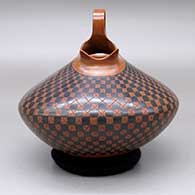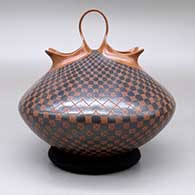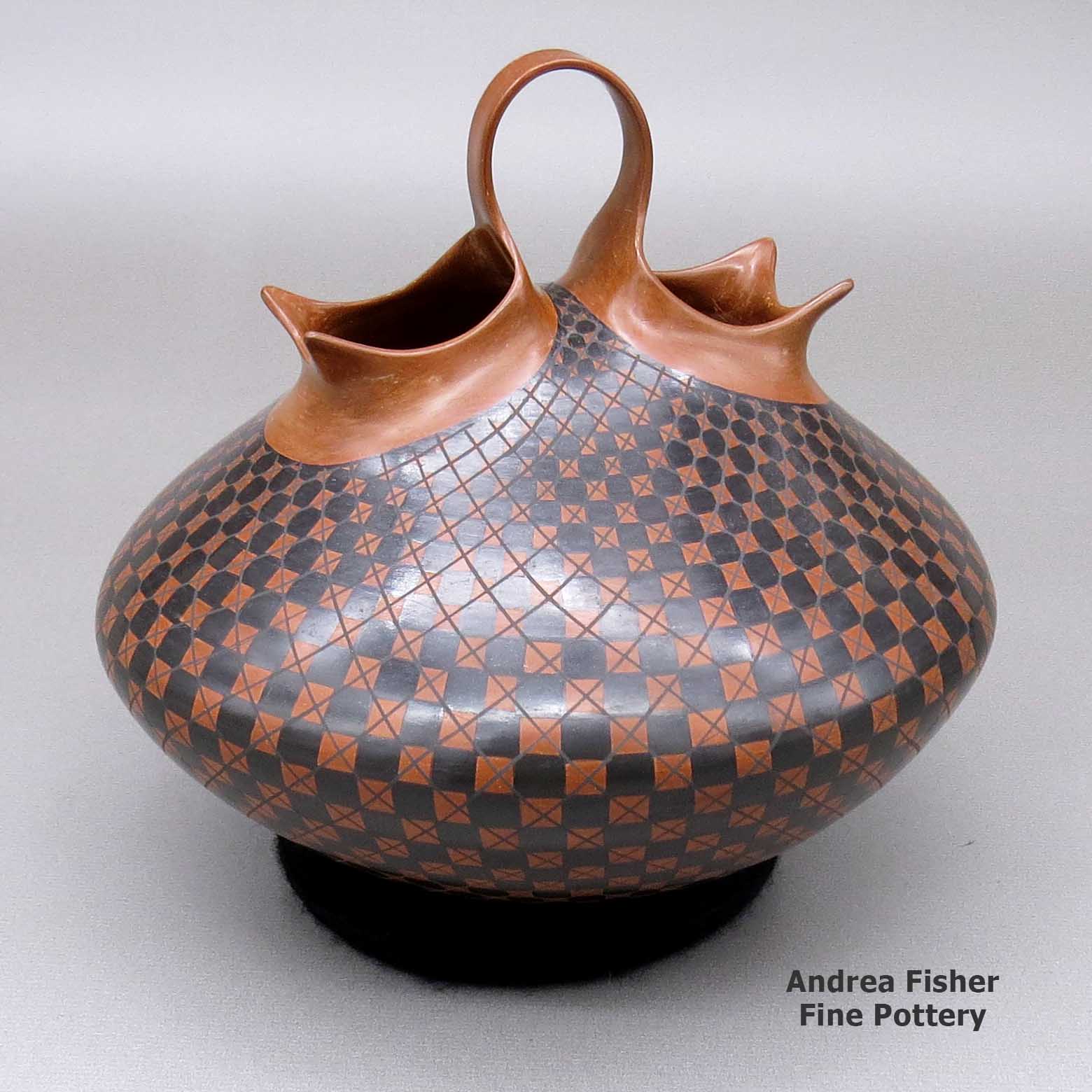
Mata Ortiz and Casas Grandes
$ 495
llcg3k436
Black-on-red wedding vase with organic flared openings and a cuadrillos geometric design
6 in L by 6 in W by 6 in H, measurement includes stand
Condition: Very good, sticker residue on bottom
Signature: Olga Quezada
Tell me more! Buy this piece!
(505) 986-1234 - www.andreafisherpottery.com - All Rights Reserved
Olga Quezada
Mata Ortiz andCasas Grandes
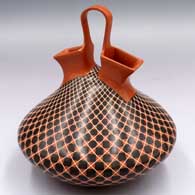
Olga Quezada de Ledezma learned how to make pottery from her neighbors, Angela Bañuelos and Gerardo Cota. Then she taught her husband, Humberto Ledezma. Humberto then went back to Gerardo and enlisted his help in perfecting his new-found talent.
Humberto makes the pots, usually using the terra cota clay Mata Ortiz is famous for. Then he sands them smooth and eggshell thin. His rims vary from fluted to round to square to double-necked (think: wedding vase).
Olga does all the painting and signs the pots. She prefers to paint variations of the checkerboard/cuadrillos pattern. She also often adds a series of thin blue lines that spiral from the top to the bottom of the piece, passing through the center of each red square.
Their work was featured at an exhibition at the University of New Mexico in 1995. Olga, Humberto and their children live in Barrio Iglesia in Mata Ortiz.
Mata Ortiz and Casas Grandes

The macaw pens at Paquimé
Casas Grandes is both a municipality and an archaeological district in northern Chihuahua State, Mexico. The archaeological district includes the pre-historic ruins of Paquimé, a city that began to build around 1130 AD and was abandoned about 1450 AD. Archaeologists are uncertain as to whether Paquimé was settled by migrants from the Mogollon/Mimbres settlements to the north or by Anasazi elite from the Four Corners region in the United States or by others. Over the years Paquimé was built into a massive complex with structures up to six and seven stories high with multiple Great Houses in the surrounding countryside. Today, the site is a UNESCO World Heritage Site.
Mata Ortiz is a small settlement inside the bounds of the Casas Grandes municipality very near the site of Paquimé. The fortunes of the town have gone up and down over the years with a real economic slump happening after the local railroad repair yard was relocated to Nuevo Casas Grandes in the early 1960's. The town was in steady decline until Juan Quezada, a poor farmer who gathered firewood in the area of the archaeological site, was inspired by fragments of ancient Paquimé pottery and even older fragments of Mimbres forms with bold black-on-white designs littering the ground to learn more.
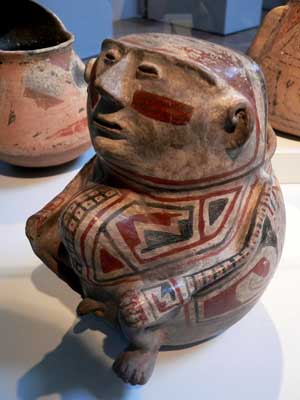
Ramos Polychrome effigy pot from Paquimé
Quezada was successful in his quest to learn to recreate the ancient process using slightly more modern techniques (although no one in the present tradition uses a potter's wheel). He learned to use sand and other coarse materials for temper. He discovered that dried cow dung made an excellent and inexpensive firing fuel. Instead of using gourds for smoothing he substituted broken hacksaw blades. Instead of using yucca fiber brushes for painting he learned to make brushes with human hair. He persevered in his efforts and by 1971 had produced a kind of polychrome pottery. Since then, most pottery-making in the area has used innovations in the design and decoration of the pots but the materials and the basic crafting of the process have remained the same.
By the mid-1970s, Quezada had attracted a significant number of traders and his work was becoming a commercial success. That is when he began teaching his techniques to his immediate family. They in turn taught other family members, friends and the younger generations. Both women and men were included from the beginning.
Originally called Casas Grandes pottery in the early years of its production, the potters of this tiny village have made such an impact on the pottery communities, including many awards and special recognition from the Presidents of Mexico, that Mata Ortiz pottery is now becoming known around the world.
Today, pottery production has changed the village in many ways as there is now electricity, plumbing, vehicles and more for the residents. Virtually everyone in the small town (2010 population: 1,182) makes their living by working in some part of the pottery-making process, from potters to clay-gatherers to firewood collectors to traders.
Mata Ortiz pottery incorporates elements of contemporary and prehistoric design and decoration, and each potter or pottery family produces their own distinctive, individualized ware. Young potters from surrounding areas have been attracted to the Mata Ortiz revival and new potting families have developed while the art movement continues to expand. Without the restraints of traditional religious practices or gender constraints, a vibrant flow of new ideas has enabled the pottery of Mata Ortiz to avoid the derivative repetition common to virtually all folk art movements. This blend of economic need, gender equality, cultural expression and artistic freedom has produced a unique artistic movement in today's community.
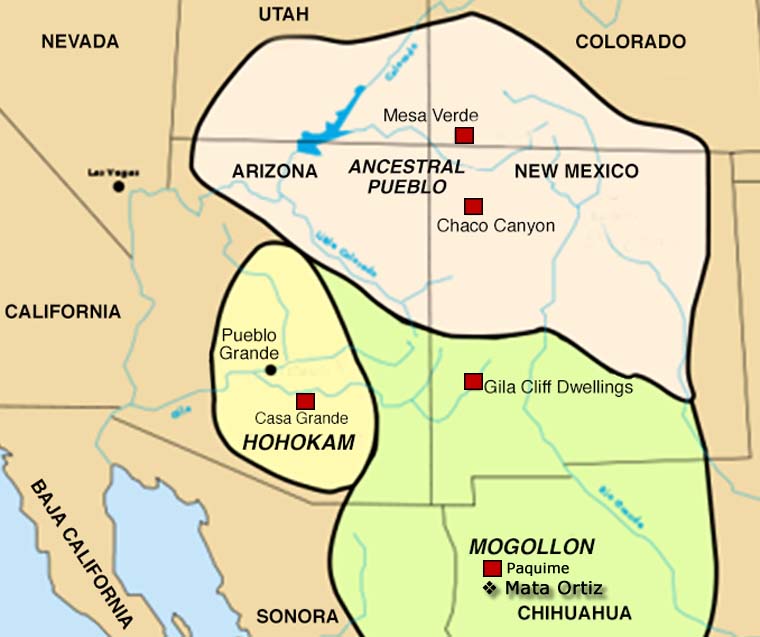
Lower photo is courtesy of David Monniaux, Creative Commons Attribution-Share Alike 3.0 Unported License
The Story of
the Wedding Vase
as told by Teresita Naranjo of Santa Clara Pueblo
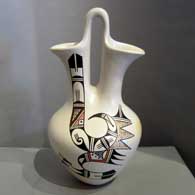
Helen Naha
Hopi
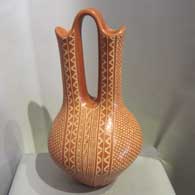
Wilma Baca Tosa
Jemez Pueblo
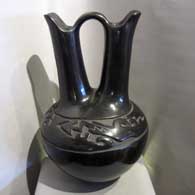
Margaret Tafoya
Santa Clara Pueblo
The Wedding Vase has been used for a long, long time in Indian Wedding Ceremonies.
After a period of courtship, when a boy and girl decide to get married, they cannot do so until certain customs have been observed. The boy must first call all his relatives together to tell them that he desires to be married to a certain girl. If the relatives agree, two or three of the oldest men are chosen to call on the parents of the girl. They pray according to Indian custom and the oldest man will tell the parents of the girl what their purpose is in visiting. The girl's parents never give a definite answer at this time, but just say that they will let the boy's family know their decision later.
About a week later, the girl calls a meeting of her relatives. The family then decides what answer should be given. If the answer is “no” that is the end of it. If the answer is “yes” then the oldest men in her family are delegated to go to the boy's home, and to give the answer, and to tell the boy on what day he can come to receive his bride-to-be. The boy must also notify all of his relatives on what day the girl will receive him, so that they will be able to have gifts for the girl.
Now the boy must find a Godmother and Godfather. The Godmother immediately starts making the wedding vase so that it will be finished by the time the girl is to be received. The Godmother also takes some of the stones which have been designated as holy and dips them into water, to make it holy water. It is with this holy water that the vase is filled on the day of the reception.
The reception day finally comes and the Godmother and Godfather lead the procession of the boy's relatives to the home of the girl. The groom is the last in line and must stand at the door of the bride's home until the gifts his relatives have brought have been opened and received by the bride.
The bride and groom now kneel in the middle of the room with the groom's relatives and the bride's parents praying all around them. The bride then gives her squash blossom necklace to the groom's oldest male relative, while the groom gives his necklace to the bride's oldest male relative. After each man has prayed, the groom's necklace is placed on the bride, and the bride's is likewise placed on the groom.
After the exchange of squash blossom necklaces and prayers, the Godmother places the wedding vase in front of the bride and groom. The bride drinks out of one side of the wedding vase and the groom drinks from the other. Then, the vase is passed to all in the room, with the women all drinking from the bride's side, and the men from the groom's.
After the ritual drinking of the holy water and the prayers, the bride's family feeds all the groom's relatives and a date is set for the church wedding. The wedding vase is now put aside until after the church wedding.
Once the church wedding ceremony has occurred, the wedding vase is filled with any drink the family may wish. Once again, all the family drinks in the traditional manner, with women drinking from one side, and men the other. Having served its ceremonial purpose, the wedding vase is given to the young newlyweds as a good luck piece.


